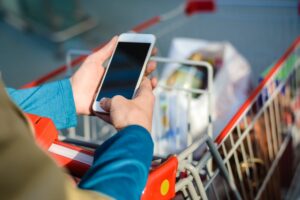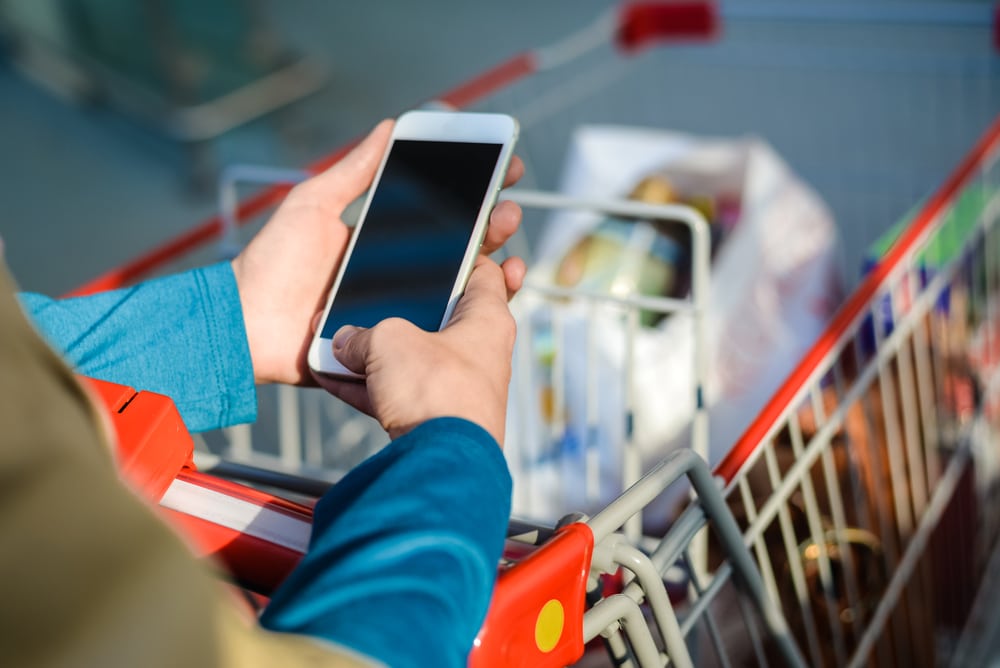The customer’s in-store experience will continue to remain relevant as long as physical shops exist. And according to recent data, brick-and-mortar stores are certainly not waning in popularity. In fact, researchers estimate that 86% of retail sales still occur at physical locations, though 53% of those purchases are influenced by the internet or mobile technology.
For many shoppers, the in-store experience continues to lag behind the digital realm in speed, convenience, and personalization. To remedy this problem, there has been a focus on merging technology with good old-fashioned customer service for an omnichannel experience that gives shoppers the best of both worlds—also known as “brick-and-mobile.”
What Does Mobile Technology Have to Do With the In Store Experience?
You might picture a person surfing the Amazon app from their couch, but that’s not how most people use their mobile devices to shop. Consumers still like to touch and see products in person, enjoying the instant gratification of taking a new purchase home same-day. Seventy-one percent of shoppers access their phones while shopping in a store. They read product reviews, search features and benefits, compare prices, navigate the aisles, checkout, or browse for gift inspiration. This number is up from just 15% in 2017, revealing that widespread smartphone adoption has a huge impact on a shopper’s in-store experience.
Ways to Improve the In Store Experience With Mobile Technology
There are a number of ways to incorporate mobile into a shopping experience to drive customer engagement, shopper satisfaction, and increased sales.
- Empower associates to provide better customer service. A whopping 89% of retailers surveyed said they planned to equip store associates with mobile devices by 2020. Specific goals included: to identify customers, increase customer engagement, look up the most recent product information, manage inventory, and accept payments.
- Allow shoppers to skip the checkout and pay on their mobile devices. Self-scanning apps can turn any mobile device into a POS system to expedite checkout. In 2017, Target launched a mobile wallet linked to REDcards and all major credit cards that made checkout four times faster than regular payment. Going one step further, Amazon Go stores use a combination of computer vision and sensor technology to allow shoppers to pick up items and simply leave the store without having to physically check out; the Amazon Go app automatically tallies up the items selected and processes the shopping trip on a linked card.
 Use beacons to broadcast relevant offers. Beacon technology allows mobile customers to receive push notifications for special offers related to where they are located in the store. Research conducted within the last five years found that 73% of shoppers who received beacon-triggered content on their phones said it increased their likelihood of making a purchase, and 61% said they would visit the store more often.
Use beacons to broadcast relevant offers. Beacon technology allows mobile customers to receive push notifications for special offers related to where they are located in the store. Research conducted within the last five years found that 73% of shoppers who received beacon-triggered content on their phones said it increased their likelihood of making a purchase, and 61% said they would visit the store more often.
- Help shoppers geo-locate products in the store through a fun third-party app. Waze-like store layout mapping is a helpful solution for big stores with multiple departments (like Home Depot), allowing customers to bypass information desks or store associates to find the products they need. Maps can be used to show SKU numbers and inventory, as well as product locations to reduce frustration even further. Shopkick uses technology that allows shoppers to find, scan, and purchase products easier, all while earning loyalty rewards for engaging with partner brands. Shopkickers are not just using the app to find products in store but as a platform for offers, rewards, gamification, and personalized shopping.
- Use mobile as a platform for offers, rewards, and gamification. Increasingly, pioneering brands are turning to “gamification” to engage customers and build brand affinity. There are countless ways to make a mundane shopping trip more fun—such as hosting giveaways, sending shoppers on treasure hunts to find products in the store, rewarding shoppers for their purchases and in-store interactions, and providing engaging content that makes product discovery enjoyable.
- Tap into the age of personalization and instant gratification. Today’s consumer wants tailored options and instant gratification for a positive in-store experience. Sephora has seen tremendous success with their latest app which allows users to virtually try on makeup, receiving over 8.5 million visits since its debut. At Frank and Oak, geolocation technology alerts a staff member to brew a fresh cup of coffee as soon as a loyalty member arrives in store. DSW VIP members unlock rewards and personalized product recommendations upon arrival.
- Implement a locker system that allows online ordering customers to “speed shop.” BOPIS is another form of technology that works to improve the in-store experience. At Nike’s flagship store in NYC, the retailer debuted a “Speed Shop.” This feature invites customers inside through a dedicated entrance to find pre-reserved shoes in their size waiting in a locker with their name on, to be unlocked by smartphone. If they like what they see, they can checkout with their mobile phones, bypassing the sales associates if desired.
It can be costly to implement strategies to improve in-store mobile experiences, but it doesn’t have to be.
Ready to Transform Demand Into Opportunity?
It can be costly to implement strategies to improve in-store mobile experiences, but it doesn’t have to be. You can start by partnering with Shopkick to offer shoppers a branded, personalized, and fun in-store experience. The Shopkick app travels with customers all along the shopping journey via their mobile device. The app enables them to interact with brands from any location and incentivizes engagement while they’re already in a shopping mindset. And when a customer enters a participating store, interacts with a featured product at shelf, or makes a purchase, they are rewarded—which makes for the perfect opportunity to increase customer engagement.
Interested in implementing a strategy to improve the in-store experience for your customers? Consider partnering with the most innovative shopping app on the market. Our partners use Shopkick to reward consumers for engaging with their products, resulting in increased brand loyalty and overall market share. Check out their success stories or contact us to get in on the action.
Image courtesy of ARIMAG





